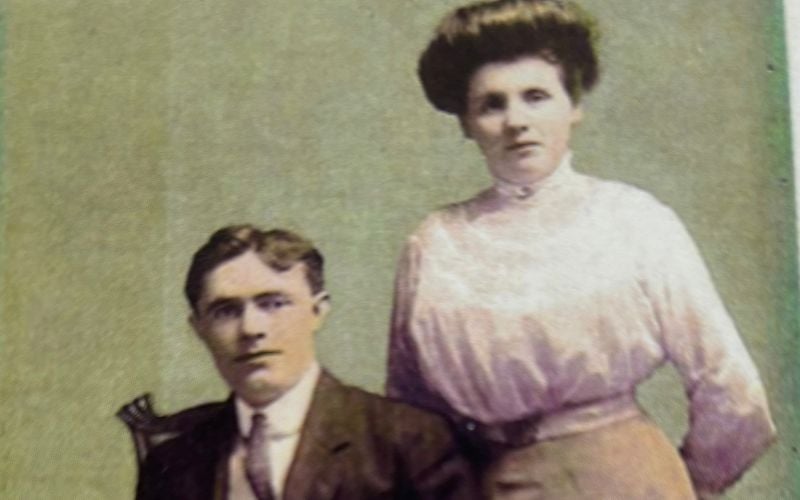St. Patrick’s Day is all about Gram’s Irish soda bread, a treat she religiously baked every March 17th. Mom lightly toasted my pieces with butter. It tasted like love.
One year, I asked Gram to teach me how to make her special recipe. In her cramped kitchen, after school, she held up a brown grocery bag, ripped it open and placed it on the counter.
“Here’s the secret,” she said. “You sprinkle this with flour, so the dough doesn’t stick when you knead it, and it doesn’t make a mess.”
"Funny secret," I thought, but I wasn’t about to question her. My gram, with her blue eyes and silver hair, bumped around her kitchen on arthritic knees. She worked alone and didn’t slow down to explain things. This felt solemn, like church.
She’d already stacked the ingredients next to her yellow Pyrex mixing bowl.
“After you use something, move it to the other side,” she said. “If you get interrupted by a phone call, you'll know what you’ve already added.”
Next, Gram sifted flour and measured the dry ingredients into her yellow bowl. She hollowed out a hole in the center and poured buttermilk, eggs, and melted margarine.
“Always use a wooden spoon to stir the batter until it becomes tacky,” she said. In went the raisins and caraway seeds. During lean seasons, she skipped the last step to save money, but those batches never tasted as good.
“Now dust your hands with flour.” She split the batter in two and handed me a clump. We stood side by side, squishing it up, down, back and forth on the floured paper bag. My fingers became a gooey mess. We placed the mounds on a baking tray, and Gram gave me a knife.
“Cut a cross into the top,” she said. A nod to our Catholic faith, its grip so strong it even got baked into our food. Gram’s people immigrated from Ireland, but it’s foggy if they came from Cork, Donegal, or the Aran Islands.
When the timer dinged, we peeked inside the oven to see if the tops had turned golden brown. A warm, musky aroma escaped. A toothpick dipped into the bread’s center came out dry, telling us it was done. Next, we mixed the glaze: warm water and confectioner’s sugar. Gram’s gnarled hands spread the mixture over the surfaces with care.
“This is the best part,” she said. "The sweet coating blends with the raisins."
My grandmother’s Irish soda bread tasted moist, not like the drier versions sold in grocery stores every March. I’ve yet to find any that compares.
Our family recipe doesn’t come from Gram’s side, but from my dad’s grandmother, Margaret “Nana” (Canty) Regan. In 1906, she came to America in steerage on the Oceanic from Co Kerry, in search of a better life.

Patrick and Nana Regan.
Nana’s daughter, my dad’s mom – Mimi – had the bluest eyes and gathered her red hair in a bun. Mimi warmly offered tea, with milk and sugar, and Sara Lee pound cake, but she rarely baked. Instead, my mom’s mom embraced their recipe as her own.
When Gram’s arthritis became debilitating, I made loaves for my New Jersey clan: one for my grandparents, one for my aunt, one for my parents, and one for my family. Some years, I cut corners and divided the dough into three smaller loaves instead of two. When I did this, my dad felt cheated: “Sis, what happened?” he’d say. “Where’s the rest of it?”
My husband, Patrick, and our sons loved my bread, served on shamrock-rimmed China. We’d gather around the table and down it in one sitting. For a while, I made Chris, our youngest, some without raisins. When he was in nursery school, I brought in my soda bread for an Ireland presentation.

Chrisopher and Alice Roche Cody at Chris' preschool presentation on Ireland, March 2006.
For years, I guarded our family recipe, sharing with a select few, such as Chris’ preschool teacher, who thanked me repeatedly on behalf of her Irish husband. Once, as I loaded buttermilk into my cart at Trader Joe’s, the store manager asked what it was for.
“How about we post your recipe in the dairy aisle?” she asked.
“Sure,” I said with a smile, thinking to myself, 'No way in hell,' as I rolled my cart away.
After we visited the Emerald Isle, I perfected the recipe. Sean, our eldest, studied a semester in Galway; it was my first trip across the pond. Impressed by the fresh ingredients pubs used, I vowed to do the same. Grass-fed eggs, Irish butter, full-fat buttermilk. I discovered that dark and gold raisins delivered a deeper flavor. During the pandemic, I baked with Chris, hoping he’d continue our family tradition.

Patrick, Christopher, Alice, and Sean Cody on the Ring of Kerry in March 2018.
Over time, things changed. First, my grandpa passed away, then Gram. One less loaf. When my parents separated, that meant a loaf for each. My dad died. One less. Then Aunt Barb. Another loss.
Last year, we spent St. Patrick’s Day in Florida, so I made Mom’s bread early and gifted one to Sean’s future in-laws. Once on Amelia Island, I realized I’d forgotten my recipe. I messaged Chris’ former teacher, and she promptly texted it. Tracking down caraway seeds became a treasure hunt. I stored my precious bounty in plastic bags for my Southern neighbors, but Clancy, our puppy, snatched one off the counter and dashed around the yard with it hanging from his mouth. Another round of baking.
Now Mom lives in a nursing home, so I’ll bring some for her and her aides. I hope I can find a suitable paper bag, as stores rarely offer them. No doubt I’ll pay top-dollar for premium eggs, but it will be worth it. I’ll cut a cross into each loaf, even though I can't find peace in my religion anymore. One constant remains: Gram’s yellow mixing bowl.
I wish I knew more about my Gram’s people, but there’s no one left to ask. I know Nana found the richer life she sought in America. She married Patrick Regan, also from Co Kerry, settled in Jersey City, and had a brood of adoring grandkids, especially my dad.
I’m proud of my Irish heritage. When I walked the cobbled streets of Galway, I felt at home. People looked so familiar. “I could be related to anyone here,” I thought. I’d found my tribe.
This St. Patrick’s Day, I’ll share Nana’s recipe and Gram’s love – my homage to my Celtic roots – one heavenly slice at a time.
Margaret “Nana” (Canty) Regan’s Irish Soda Bread
(Adapted by Alice Roche Cody)

Alice Roche Cody's Alice Roche Cody's Irish soda bread on shamrock-rimmed China.
Ingredients:
(Use local, grass-fed, organic ingredients wherever possible!)
- 5-6 cups flour (4 cups, use extra to dust hands and surface for kneading)
- 1 tsp. baking soda
- 3 tsp. baking powder
- 1 tsp. salt
- 1 cup sugar
- 1/2 stick margarine (unsalted Irish butter)
- 2 eggs
- 1 tsp caraway seeds (1 Tbsp.)
- 1/2 box raisins (½ box gold & ½ box dark)
- 2 cups buttermilk (full fat)
Method:
Sift flour and mix all dry ingredients and seeds. Make hole in center, pour in buttermilk, eggs, and melted margarine (butter). Add raisins. Mix with wooden spoon until tacky.
Knead and divide into 2-4 round loaves. Cut a cross on top of each.
Bake at 350 degrees until brown. (About 45-60 minutes). Place on cooling rack and glaze with warm water mixed with confectioner’s sugar.
Enjoy!
*Alice Roche Cody, a freelance writer based in New Jersey and Florida, has written for The Record, Columbia Journalism Review, The Star-Ledger, NJ.com, The Rumpus, The Black River Journal, First Time Parent, and TIFERET Journal. Her essay, “A Sacred Gift,” was included in the book, "This I Believe: On Motherhood" (Wiley & Sons). This fall, she and her husband will visit Ireland for their 30th wedding anniversary. You can learn more about Alice on her website AliceRocheCody.com.




Comments